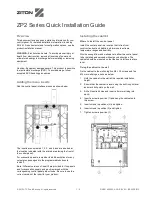
2 / 2
P/N 501-405203-4-30 • REV 03 • ISS 23FEB13
Connecting loops and loop devices
For optimal system performance, we recommend a twisted-pair
loop cable, 12 to 26 AWG (0.13 to 3.31 mm²), with 75
Ω max.
and 700 nF max. (based on 3.5 km max. cable length with
2 mm² diameter for up to 127 devices).
Class A loops are supervised for open and short circuits.
Terminate unused Class A loops A (+) to B (+) and A (
−) to
B (
−). Each Class A loop can support up to 127 devices.
See the product installation manual for Class B loop
connection information.
Connecting inputs and outputs
Caution:
The following connection information does not apply
to installations requiring EN 54-13 compliance. If EN 54-13
compliance is required, see the product installation manual.
All inputs and outputs (except 24V AUX) require a 1
5 kΩ end-
of-line resistor for termination to detect open or short circuits. If
an input or output is not used, install a 15 kΩ end-of-line
resistor across the unused terminals to avoid an open circuit
fault.
Connect input switches to INPUT1 and INPUT2 (62
Ω
≤
active
value
≤
8 kΩ).
When connecting outputs, observe polarity or install a 1N4007
diode or equivalent to avoid inverted activation issues.
See the product installation manual for input and output
configuration options.
Mains fuse and batteries
Use a T4A-250V mains fuse for both 110 VAC and 240 VAC
operation. Check the product installation manual for 110 VAC
operation requirements.
The control panel requires two 12 V, 7.2, 12, or 18 Ah
rechargeable sealed lead-acid batteries. For detailed battery
requirements, see the product installation manual.
Configuration
See your product installation manual for detailed configuration
information. The default installer password is 4444.
Contact information
For contact information, see www.utcfssecurityproducts.eu.
Overview of typical fire system connections using a single Class A loop





